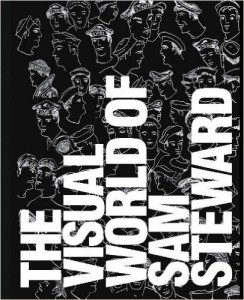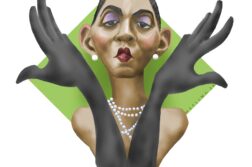 An Obscene Diary: The Visual World of Sam Steward
An Obscene Diary: The Visual World of Sam Steward
Edited by Justin Spring
Elysium Press/Antinous Press
320 pages (illustrated), $150.
READERS of Justin Spring’s recent biography, Secret Historian: The Life and Times of Sam Steward, Professor, Tattoo Artist, and Sexual Renegade, may be curious to see some of the erotic visual art that Steward produced. For them, Spring has put together a limited-edition companion book called An Obscene Diary: The Visual World of Sam Steward. Fans of gay erotica may be more familiar with Steward’s pseudonym, Phil Andros, which he used for titles like $tud and My Brother, My Self, erotic novels that defied mid-20th-century publishing wisdom by portraying characters who weren’t guilt-ridden or suicidal about having gay sex. Until now, a record of Steward’s visual art was virtually impossible to get ahold of, but Spring was able to track down Steward’s lost archives, which he found, reeking of dog urine, in the attic of Steward’s executor.
Specialty publisher Elysium Press—known for reissuing gorgeous hand-printed editions of rare or neglected gay themed books—has packaged 1,000 hardcover slipcase copies that evoke the feeling of reading an old scrapbook, and Spring’s accompanying text provides an excellent overview of Steward’s visual art and the life events that informed it. Most of the items chosen for An Obscene Diary were created by Steward between 1949 and 1956, a very fertile period when he was trying to find his voice as an artist and experimenting with different visual media. His foray into the erotic visual arts ended in 1956, however, shortly after he was outed and forced to resign from DePaul University, where he was a distinguished and well-liked English professor. After this experience, Steward stopped making visual porn in order to devote himself more fully to the two endeavors that would make him famous: writing porn and tattooing.
Spring’s apt title for An Obscene Diary was suggested by Steward himself in a letter written in the early 1950’s to photographer George Platt Lynes, a friend who was eager to view a collection of X-rated Polaroids that Steward had taken of himself having sex with rough trade. Steward asked Lynes to view his Polaroid images as “a kind of obscene diary … with no art.” As Spring points out in his introduction, that pretty much sums up this book, whose appeal isn’t primarily due to Steward’s visual style but instead to the delight of witnessing a gay man’s sexual exploits during the McCarthy era.
To be sure, there is no high art in this book, or even much that the average gay man in the Manhunt era is likely to find arousing among the dozens of quaint, black-and-white Polaroids that make up most of it, but one has to marvel at the audacity of Steward and his pre-Stonewall co-conspirators, particularly those who were willing to be photographed in flagrante despite being straight and in the military. Most were hustlers, which explains the bored, faraway look on so many of their faces while getting a blow job or performing in one of Steward’s droll narratives involving sailors or bikers. Despite being twice as old as most of his tricks, Steward was in great shape at this time. But his angular features, pomaded hair, and thin mustache made him look like Clifton Webb in Mr. Scoutmaster. According to Spring, Steward intended his Polaroids to be playful mementos for himself and his friends rather than masturbatory fodder. Taken in his Chicago apartment between 1951 and 1956, they offer a bold glimpse of what gay sex in the 50’s actually looked like, albeit through the lens of Steward’s sexual fetishes.
His obsessions included sailors, bikers, group sex, sadomasochism, interracial sex, and tattoos—all of which he documented, both with his Polaroid camera and by keeping a “Stud File,” a set of 746 annotated index cards on which he recorded the details of every sex act he ever performed, and with whom. When Alfred Kinsey got wind of the Stud File, he sought out Steward and made him an “unofficial collaborator” in his ongoing research on male homosexuality. Kinsey and his fellow researchers interviewed Steward regularly about his sex life, both in his apartment and at the Kinsey Institute, where he was filmed having sadomasochistic gay sex. Steward and Kinsey’s shared interest in analyzing male homosexuality would develop into a platonic friendship that lasted until Kinsey’s death in 1956. According to Spring, Kinsey undoubtedly looked at most, if not all, of the items that ended up in this book before he died, much of which was copied for the Kinsey Library.
An Obscene Diary includes photocopies of over seventy of the index cards from the Stud File, which catalog in painstaking detail every one of Steward’s rim jobs, daisy chains, and hustler fees from 1925 to the early 1980’s. Of special interest are the data he compiled on the handful of celebrities with whom he had sex over the years, including Rudolph Valentino and Thornton Wilder. Who knew James Purdy’s penis was short and thin, or that, according to Steward’s coded entry, Rock Hudson’s was “average, bent, and thick”?
Equally remarkable, again more for subversive boldness than originality, are the samples of Steward’s erotic drawings, paintings, decorative objects, and tattoo designs. Looking for a way out of the stifling academic closet of the 1940’s, Steward began taking figure drawing and illustration classes at the School of the Art Institute of Chicago, where he contemplated becoming a freelance illustrator of homoerotic subjects. He would end up becoming a renowned tattoo artist instead, using the name “Phil Sparrow” and authoring a social history of tattooing titled Bad Boys and Tough Tattoos (1990). One can see him heading in that direction in the horny sailors he drew for his first pornographic novella, Bell Bottom Trousers (1943). Like all of Steward’s visual work, these illustrations were rendered in a whimsical, cartoonishly sexy style, like crude Paul Cadmus or Tom of Finland drawings, a technique perfectly suited for tattooing.
Other works culled from Steward’s brief period of visual experimentation include: a clever parody of Aubrey Beardsley in which the Seven Deadly Sins are attributed to phallocentrism; an expressionistic re-imagining of erotic illustrator Neel Bate’s The Barn; some of his tattoo flash—unusual for its gay 50’s sensibility; a Polaroid of the Cocteau-esque wire profile sculptures of a sailor and a biker hanging in Steward’s apartment; photos of the erotic murals Steward painted over his Murphy bed; and Steward’s take on Genet’s Querelle, in which he used himself as the model for the Armenian pederast who gets strangled by Querelle. Two things the book is missing are page numbers and captions, making it difficult to refer to any particular image or file.
Steward was nothing if not self-aware, and he obviously had a delightful sense of humor, something one sees in the photo of the shrine he built from a cluster of Rudolph Valentino’s pubic hair, which he somehow managed to snag during their one assignation in a hotel room in Columbus, Ohio, when Steward was still a senior in high school. Madcap sexual nostalgia like that permeates every page of this obscenely fascinating time capsule of gay sex before Stonewall.
James Farley is an associate editor of this magazine.






